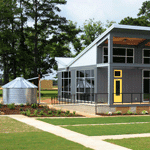This article is part of gb&d‘s Green Typologies series In the Workplace.
When Ben Copeland Jr. returned home from studying water use on an agricultural trade mission trip to Israel with the Georgia Department of Agriculture, the Super-Sod vice president knew it was time for rural Georgia to get green—and it couldn’t have come at a more perfect time. Based in Ft. Valley, Georgia, Super-Sod, famous for its turfgrass sod and seed, had been operating out of two small offices that were 20 miles apart. After undergoing some internal restructuring, it decided to combine the two offices, but neither space was large enough to house all of the employees. It made the most sense to start fresh.
“We wanted more than a boring office building,” Copeland says. “We wanted our new office to reflect who we were as a company, and we wanted it to showcase what we do. On my trip to Israel, I learned so much about blending new and old technology together to maximize water use. I started to think about how for thousands of years people have been able to make the desert bloom with limited water resources through the use of rudimentary technology like cisterns, yet here in Georgia, where we experience plenty of rainfall even in a ‘dry’ year, we weren’t really being good stewards of our resources. Our new office is a step in the right direction.”

The new Super-Sod building features a 9,000-gallon above-ground cistern that irrigates its sod plots and Drivable Grass permeable pavers.
With Super-Sod’s new headquarters, sustainable landscaping is key. One of the building’s most important features is its butterfly roof, which captures more rainwater than a traditional gabled roof. Super-Sod invested in an ECO-MAT Subsurface Drip Irrigation system by Hunter, an extremely efficient way to water the company’s many product displays around the perimeter of the office. Not only does it use less energy, but it also cuts down on evaporation and, according to Copeland, is like “injecting water directly into the plant.”
The company spent just $400 on a new technology that has already paid for itself: the ETwater HermitCrab, an irrigation controller that uses internet-based technology to determine when, how, and for how long plants should be watered. “The HermitCrab system is amazing because it only provides the exact amount of water the plant will need,” Copeland says. “It can save up to 50 percent water savings of a regular irrigation system, and it doesn’t require that you redo your entire system.” Of course Copeland also ensured that the new office space featured two cisterns; the one aboveground holds 9,400 gallons of water and the one belowground holds 7,600 gallons.
Water use was the starting point, but Super-Sod also capitalized on the Georgia sunlight by adding as many windows as possible and purchased energy-efficient fans from Big Ass Fans, a choice that drastically reduced the building’s energy use. According to Copeland, at the height of summer Super-Sod’s most expensive energy bill was $250. At just one of its former offices, half the size of their current one, energy bills easily could reach $400. The building also features spray-foam insulation, and local, renewable wood was used for flooring, walls, and ceilings.
“Our new office is sustainable, but more than that, it’s educational,” Copeland says. “We stick out because our building is so different than every other building in rural Georgia. People literally stop by to check out the building, and while they’re here, they can learn about the new and old technology being used. It’s so much more than what we were trying to do; this building has become more than just an office space.”
This article is part of gb&d‘s Green Typologies series, which in each issue explores a single type of building. For more of our most recent collection, In the Workplace: Four Innovative Offices, choose from the list below:
- Power and Light: Nova Scotia Power Headquarters by WZMH Architects
- Schneider Works Smarter: Schneider Electric offices
- From Operating Rooms to Offices: CFA Institute offices

